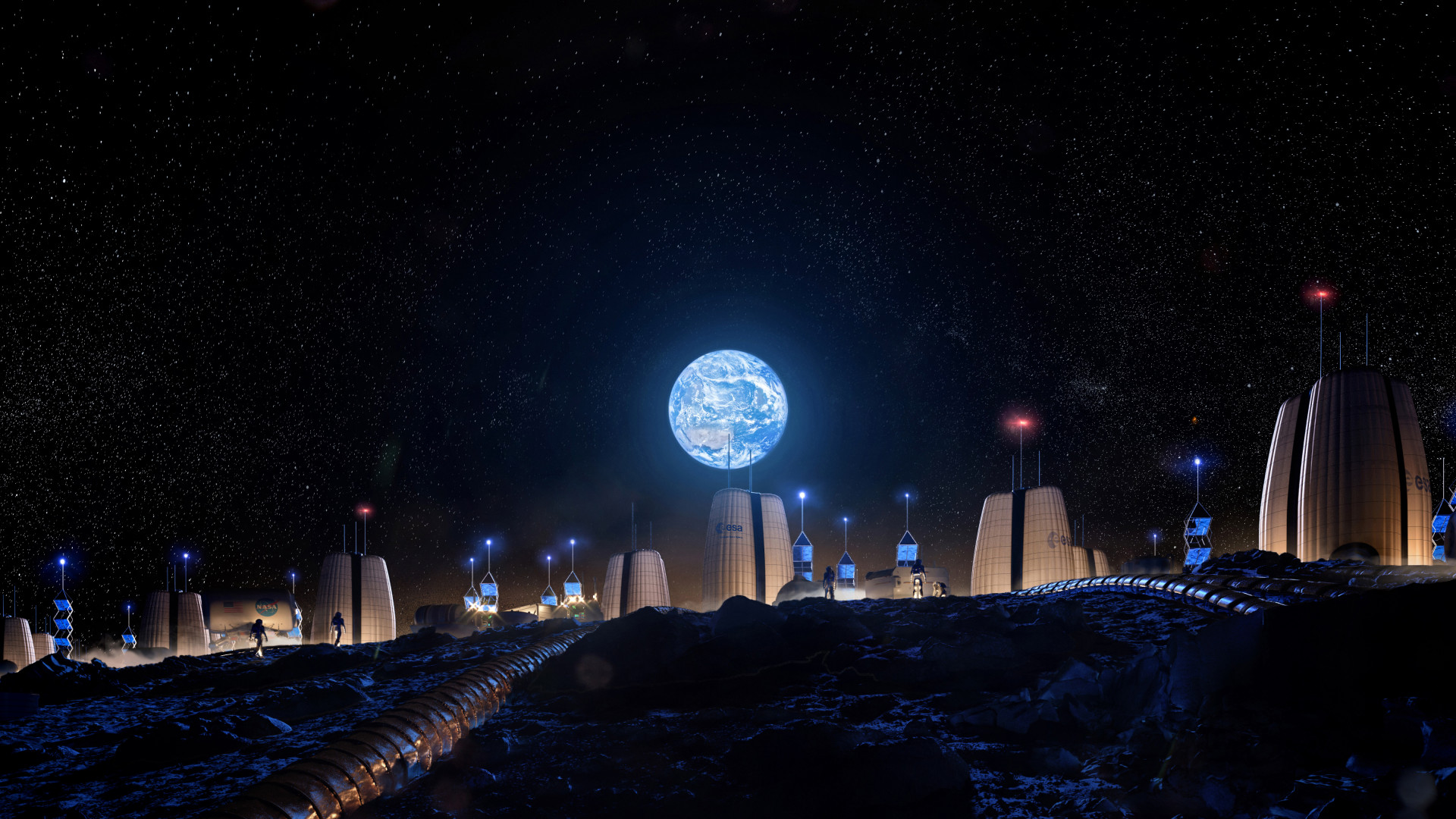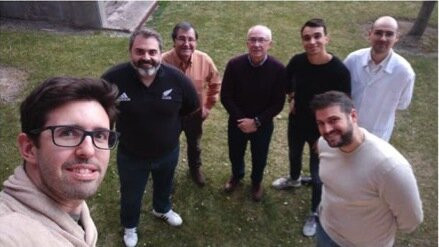
Metalysis–ESA Grand Challenge: team Malt wins first phase • May 2021
Metalysis and ESA announce team Malt as winner of the first phase of the Grand Challenge to develop innovative techniques for future lunar settlements.
"ESA’s Grand Challenge fosters New Space initiatives in Europe and this brings us into contact with dynamic start-up companies such as Malt. Our first challenge, in partnership with Metalysis, moves us closer to our space exploration goals and will stimulate space commercialisation in line with ESA’s Agenda 2025,” commented ESA Director General Josef Aschbacher.
The Metalysis–ESA Grand Challenge was launched in 2020 and offers a prize of €500 000, fully sponsored by Metalysis. It rewards new miniaturised technology that will improve and enhance the Metalysis-patented electrolytic process which is able to extract oxygen and titanium from regolith found on other planets.
Metalysis, a UK-based metallurgy company, chose team Malt, a Spanish interdisciplinary group active in biomedicine and space applications, as winner of the first phase of the Metalysis–ESA Grand Challenge, and has awarded them €50 000.

Selected by a panel of experts, Malt, provided a detailed description of the functions and processes to devise process-monitoring systems that could fit with Metalysis electrochemical cells on Earth, and accompany the development of the associated technology in space.
“Participation in this challenge has represented a great opportunity to apply and expand our team expertise in fields ranging from the application of spectroscopic techniques for material processing to space hardware development,” said Guillermo Lopez. “We’re looking forward to the next phase and feel proud that we are contributing to facilitate human over robotic exploration of other planetary bodies, it is a super exciting challenge.”
The competition has entered its second phase during which a breadboard which best meets the requirements of the challenge, will be awarded the remaining half million euro prize money.
Ian Mellor, Managing Director at Metalysis commented: “We were impressed by the potential solution proposed by the Malt team, drawing on their expertise in the development of spectroscopic techniques, and applying this to the in situ process monitoring of the Metalysis process, during Phase 1 of the Grand Challenge. Furthermore, we look forward to following progression of the concept throughout Phase 2, to ultimately testing the hardware in our metal powder and oxygen production technology.”
Towards a lunar economy
As ESA and other agencies prepare to send humans back to the Moon – this time to stay – technologies that make use of materials available in space, called in situ resource utilisation (ISRU), are seen as key to sustainability, and a stepping stone in humankind's adventure to Mars and farther into the Solar System.
ESA encourages European industry to invest in the development of optimised technologies and systems that support future space exploration, the added benefit being that these ideas can also address sustainability and scarcity of resources on Earth.
Key sectors include metallurgy, chemical processing, mining, as well as the oil and gas industry. In the longer term, resources in space may even be used on Earth.
The ESA Grand Challenge is part of the Agency’s commitment to foster new European entrepreneurs, innovation-led start-up companies and new ventures.
Metalysis process Metalysis process Metalysis has spent more than a decade developing and scaling up its electrochemical technology; a process that converts refined oxides and ores directly into valuable metal alloy powders used in 3D printing for aerospace, automotive and high-value manufacturing.
This electrolysis technology provides a potential efficient solution for ISRU as well as terrestrial applications. However, the direction of development for lunar or martian ISRU may be different for terrestrial applications.Metalysis was recently awarded ESA funding for its ‘The Metalysis Fray-Farthing-Chen (FFC) Cambridge process for extra-terrestrial oxygen production from ISRU’ project, which forms part of ESA’s Space Resources Strategy and is carried out within ESA’s General Support Technology Programme.
More articles of the category: Space Economy Articles
Space-based Solar Power: Contributing to achieving Net Zero...
Beyond Borders: Satellite Applications for Humanitarian Emer...
OECD Policy Paper: How the War in Ukraine is affecting Spac...
ESA Space Operations and Space Safety activities: supporting...
Seven Benefit Case Studies of ESA's Space Safety programme
ESA ARTES Partnership Projects, providing the satcom industr...
ESA Science Core Technology Development Success Story - Grou...
European Centre for Space Economy and Commerce (ECSECO) conc...
Europe decides to increase ESA’s budget by 17% compared to t...
The European Commission publishes the 2021 Edition of its Be...
OECD’s examination of Space Technology Transfers and their C...
PwC’s ‘Lunar market assessment: market trends and challenges...
FutureEO, critical enabler of EO benefits for the European e...
ESA TIA ARTES programme’s continuous boost to the commercial...
Terrae Novae: from inspiring Europe’s generations to support...
Exploiting the remarkable potential of space technology tran...
Technology developments for ESA science missions empowering...
Space Economy activities to support ESA Council at Ministeri...
ESA Space Economy Team presents a paper on “Statistic and th...
ESA-Eurostat workshop on a European Space Economy Satellite...
European Centre for Space Economy and Commerce (ECSECO) offi...
European Centre for Space Economy and Commerce (ECSECO) pres...
ESPI Yearbook 2021 – Space Policies, Issues, and Trends of t...
ESA Science Core Technology Development Success Story - Broa...
ESA Science Core Technology Development Success Story - Game...
ESA Science Core Technology Development Success Story - Fost...
ESA Science Core Technology Development Success Story - Crit...
ESA Science Core Technology Development Success Story - Unri...
ESA Science Core Technology Development Success Story - Firs...
ESA Technology Transfer Success Story - Closing the loop: ho...
ESA Technology Transfer Success Story - The missing layer: h...
ESA Technology Transfer Success Story - Cities as Spaceships...
ESA Technology Transfer Success Story - Space-style control...
ESA Technology Transfer Success Story - Using space heritage...
ESA Technology Transfer Success Story - No such thing as a w...
ESA Technology Transfer Success Story - Powering a village f...
ESA Technology Transfer Success Story - Space at home: using...
ESA Technology Transfer Success Story - Landing zone assessm...
ESA Technology Transfer Success Story - Uncovering the secre...
ESA Technology Transfer Success Story - From space debris to...
ESA Technology Transfer Success Story - Dry electrodes to mo...
ESA Technology Transfer Success Story - A new perspective: s...
Eurospace releases its annual Facts & Figures Report: The Eu...
ESPI Space Venture 2021 – Entrepreneurship and Investment in...
ECSECO open for membership registration on its official webs...
OECD's analysis of the impacts of Covid-19 on the Space indu...
Post-crisis scenarios for the space industry
Resilience of the space sector to the Covid-19 crisis
China’s Space Sector: Commercialisation with Chinese Charact...
The socio-economic value of satellite Earth observations: hu...
ESA Centre to develop Europe’s Space Economy and promote com...
The OECD Space Forum launches second phase of research oppor...
EARSC showcasing Copernicus uses for Environmental Complianc...
The OECD’s stand of “What is Impact Assessment”
Creation of the European Centre for Space Economy and Commer...
Value created by ESA's Space Systems for Safety and Security...
A closer look at the European Commission’s Guide to Cost-Ben...
EUSPA publishes EO and GNSS Market Report 2022
BEA’s “Estimating the United States Space Economy Using Inpu...
A closer look at the latest Earth Observation Services Indus...
ESPI Yearbook 2020 – Monitoring the development of the Europ...
EARSC workshop showcasing 24 Copernicus Sentinel value case...
SPAC and the Space Industry
G20 Space Economy Leaders Meeting 2021
ESA joins the Universeh inaugural conference to address the...
OECD’s approach to space sustainability and the economics of...
ESA announces winners of the Global Space Markets Challenge
Global Space Markets Challenge: Longlists announced
Top 12 companies selected in Global Space Markets Challenge
The Size & Health of the UK Space industry in 2019
Global Space Markets Challenge Competition
Copernicus Sentinel data supporting the pulp and paper indus...
Entrepreneurship and private investment trends in the Europe...
Space Architecture: Economic impacts, future developments an...
ESA_Lab@UCLan: Assessing the public value of ESA programmes
ESA_Lab@Kozminski: A new bird in the nest of ESA_Lab
Call for participants: OECD's initiative on the value and su...
Financing SMEs: options for SMEs and Midcaps in Europe
Copernicus Sentinel Data supporting wine making in France
ESA_Lab@PoliBa: De’ remi facemmo ali
OECD’s analysis of the impacts of Covid-19 on the space indu...
Financing space: options for SMEs and midcaps in Europe
Discussing impact assessment of Big Science projects during...
ESA and Metalysis Organised the First Grand Challenge Midter...
Why it is important to keep investing in space during and af...
The benefits of Copernicus’ Sentinel data to society, enviro...
Join the First Online Global Space Economic Workshop
Join the Third Online Global Space Economic Workshop
Join the Second Online Global Space Economic Workshop
Watch again the GSEW Online
A closer look at OECD’s methodology for assessing the scient...
Non-space business? We want to hear from you
Discussing solutions at the Global Space Economic Workshop
The Covid Crisis: for European SMEs, this could be a breakth...
Value created by ESA's Clean Space Initiative
Value created by ESA's Ground Systems Engineering and Operat...
Value created by ESA Science Programme
Value created by ESA's Future Earth Observation Pillar
Value created by ESA Telecommunication Partnership Projects
ESA and Metalysis decide to suspend temporarily the Grand Ch...
Two Teams Competing for a Half-million Prize
Watch again the GSEF 19
Interview with Eric Morel de Westgaver on Europe's space eco...
Global Space Economic Forum: Space Creates Value
ESA at the New Space Economy European Expoforum
Kick off of Metalysis – ESA Grand Challenge: the Race to Min...
ESA Grand Challenge rewards solutions to complex problems
Advancing the understanding and measurement of the societal...
ESA Space Economy Brochure
The socio-economic impact of space activities
ESA at the New Space Economy European Expoforum
Space cybersecurity for smart cities
Setting the stage
Compete in a lunar economy
Last chance to join the competition
Interview with Giulia Pastorella on cybersecurity
Interview with Guglielmo Baeli on the oil and gas sector
Interview with Vincent Bastide on construction
Global Space Economic Workshop
Global Space Economic Workshop
Building cybersecurity at the Global Space Economic Workshop
ESA announces first Global Space Economic Forum
Welcome to the Global Space Economic Workshop
ESA Global Space Economic Forum
What is the Space Economy?
Measuring the Space Economy
Creating value
Challenges of future urban settlements on the Moon and Mars
Building and powering by disruptive innovation
Space workshops to power urban innovation
ESA at Station F: looking for applications to the first Gran...
Game changers for the ESA Grand Challenge
The Moon Race: Pioneering Sustainable Lunar Exploration
Metalysis–ESA Grand Challenge launched
A community of innovation at the Farnborough Airshow and ESA
Join us at Le Bourget to discuss space for commercial purpos...
Fuel the future by joining the Innovation Exchange
